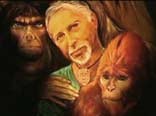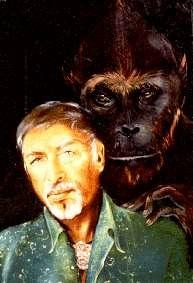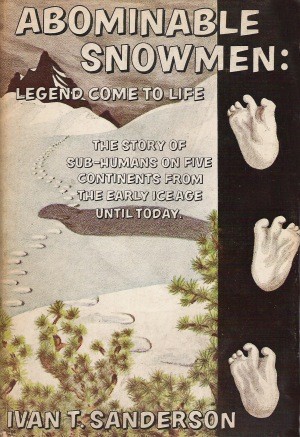Cryptozoology, Cryptid and Hominology
Posted by: Loren Coleman on August 29th, 2007

Bernard Heuvelmans and some friends.
Once again, I’m on the road soon, so today might be a great time to send along some material for the new people that are now coming here. It is always good to have everyone on the same page with definitions, and many people are surprised to hear who invented some of the words in our field. Most of the time when one coins words, such as I did for the “Dover Demon,” it is because you are in the heat of the pursuit. Or the new term could be a media construction, such as the origins of “Mothman” from an Ohio copyeditor who liked the “Batman” program on television in 1966.
But for some words, it is a more thoughtful process. People are always asking questions about the origins of “cryptozoology.” Since I have written often and frequently in the last few years about the revisionist view that it was Sanderson, not Heuvelmans, perhaps it is time to repost/revise/reveal once again my writings in one place on the big three – cryptozoology, cryptid, and hominology.
So leap in to the wonderful world of these words with me.
Cryptozoology
Cryptozoology, as everyone reading here probably knows, means “the study of hidden animal.” Do these hidden, unknown, or yet-to-be discovered animals have to be bigger than say a cat? Do they have to have an impact on humans? These are items up for debate under the term “cryptid,” below.
But what of the origins of “cryptozoology.”

In 1955, Belgian zoologist Bernard Heuvelmans wrote a groundbreaking book in French, a now classic opus entitled (in English) On the Track of Unknown Animals. But in the 1955 French and the 1958 English editions, you will not find the word “cryptozoology,” in any language.
The first published use of the word “cryptozoology” in French, occurred in 1959 in a book by wildlife biologist Lucien Blancou, dedicated to “Bernard Heuvelmans, master of cryptozoology.” At least, that is as far as we know.
But who used any form of the word first in print? And who invented it?
The premiere utilization of the term “cryptozoological,” in English, was in 1961, in Abominable Snowmen: Legend Come to Life by Ivan T. Sanderson.
In Heuvelmans’s 1968 book In the Wake of the Sea Serpents, it is clear that the word “cryptozoology” had been around for perhaps over twenty years before it came into print in 1959. Speaking of two articles on water monsters written in 1947 and 1948 by Ivan T. Sanderson, Heuvelmans wrote: “When [Sanderson] was still a student he invented the word ‘cryptozoology,’ or the science of hidden animals, which I was to coin later, quite unaware that he had already done so.”
Intriguingly, Heuvelmans apparently left this paragraph out of later French (and English?) editions of this same Sea Serpent book.
Here are the research questions of the day?
Are there other early uses of “cryptozoology” in print between 1947-1959, undiscovered by myself and French colleagues Michel Raynal and Jean-Luc Rivera? When? Where? By whom?
Are there other published examples, in English, from Sanderson or anyone else, of the use of “cryptozoology” before 1961?

++++++
Cryptid
The following definition is adapted from the one I wrote for my 1999 book, co-authored with Jerome Clark, Cryptozoology A to Z. I share it with those on Cryptomundo that are not aware of the full meaning. And throw it out for discussion and debate by those that feel it has expanded or shrunk.
+++++
“Cryptid” is a relatively new word used among professionals and laypeople to denote an animal of interest to cryptozoology. John E. Wall of Manitoba coined it in a letter published in the summer 1983 issue of the ISC Newsletter (vol. 2, no. 2, p. 10), published by the International Society of Cryptozoology. Recently “cryptid” was recognized by the lexicographers at Merriam-Webster as a word of legitimate coinage, though it has yet to appear in their dictionary, as of 1999.
Cryptids are either unknown species of animals or animals which, though thought to be extinct, may have survived into modern times and await rediscovery by scientists. “Cryptid” is derived from “crypt,” from the Greek kryptos (hidden); “id,” from the Latin ides, a patronymic suffix; and the Greek “ides,” which means “in sense.” When the suffix id is used it typically applies to an implied lineage or similar usages, as in “perseid” (meteors appearing to originate from Perseus, typically around August 11).
Bernard Heuvelmans’s definition of cryptozoology itself was exact: “The scientific study of hidden animals, i.e., of still unknown animal forms about which only testimonial and circumstantial evidence is available, or material evidence considered insufficient by some!”
Over the pre-turn-of-the-century decade (i.e. 1989-1999) some have suggested that the science of cryptozoology should be expanded to include many animals as “cryptids,” specifically including the study of out-of-place animals, feral animals, and even animal ghosts and apparitions. In the journal Cryptozoology, Heuvelmans rejects such notions with typical thoroughness, and not a little wry humor:
Admittedly, a definition need not conform necessarily to the exact etymology of a word. But it is always preferable when it really does so which I carefully endeavored to achieve when I coined the term “cryptozoology.” All the same being a very tolerant person, even in the strict realm of science, I have never prevented anybody from creating new disciplines of zoology quite distinct from cryptozoology. How could I, in any case?
So, let people who are interested in founding a science of “unexpected animals,” feel free to do so, and if they have a smattering of Greek and are not repelled by jaw breakers they may call it”aprosbletozoology” or “apronoeozoology” or even “anelistozoology.” Let those who would rather be searching for “bizarre animals” create a “paradoozoology,” and those who prefer to go a hunting for “monstrous animals,” or just plain “monsters,” build up a “teratozoology” or more simply a “pelorology.”
But for heavens sake, let cryptozoology be what it is, and what I meant it to be when I gave it its name over thirty years ago!
Unfortunately, many of the creatures of most interest to cryptozoologists do not, in themselves, fall under the blanket heading of cryptozoology. Thus, many who are interested in such phenomena as the so-called Beasts of Bodmin Moor (not unknown species but a known species albeit in an alien environment) and the Devonshire/Cornwall “devil dogs” (not “animals” or even “animate” in the accepted sense of the word, and thus only of marginal interest to scientific cryptozoologists) think of these creatures as cryptids.
More broadly, then, we do not know whether a cryptid is an unknown species of animal, or a supposedly extinct animal, or a misidentification, or anything more than myth until evidence is gathered and accepted one way or another. Until that proof is found, the supposed animal carries the label “cryptid,” regardless of the potential outcome and regardless of various debates concerning its true identity. When it is precisely identified, it is no longer a cryptid, because it is no longer hidden.

While Heuvelmans created cryptozoology (independently, and later than the coining of the word by Ivan T. Sanderson – shown at left) as a goal-oriented discipline (endeavoring to prove the existence of hidden animals), the fact that some of these cryptids will turn out not to be new species does not invalidate the process by which that conclusion is reached and does not retroactively discard their prior status as cryptids. For example, the large unknown “monster” in a local lake is a cryptid until it is caught and shown to be a known species such as an alligator. It is no longer hidden and no longer carries the label “cryptid,” but that doesn’t mean it never was a cryptid.
It is often impossible to tell which category an unknown animal actually inhabits until you catch it. Until then, it is a cryptid.
The definition (with new notes) is from Cryptozoology A to Z (NY: Fireside/Simon and Schuster, 1999) pp. 75-77.
++++++
Hominology
“Russian researcher Dmitri Bayanov coined the word ‘hominology’ around 1973, to denote those investigations that study humanity’s as yet-undiscovered near-relatives, including Almas, Yeti, Bigfoot/Sasquatch, and other unknown hominoids. He further defined hominology as a ‘branch of primatology, called upon to bridge the gap between zoology and anthropology’ in a 1973 letter to the London primatologist John Napier. His English paper on the subject was a major breakthrough contribution after decades of unpublicized Russian research and expeditions. The paper, ‘A Hominologist View from Moscow, USSR,’ appeared in Northwest Anthropological Research Notes, (Moscow, Idaho), vol. 11, no. 1, 1977.”- Loren Coleman, in Jerome Clark’s and Loren Coleman’s Cryptozoology A to Z
The words above were mostly written in the 1990s. Today, I have modified them slightly, but also would add that the Russians consider their study that of unknown or hidden hominids only, not of unknown hominoids, because they are not interested, allegedly, in any unknown hairy pongids that may be into the mix.
While some non-Russian Bigfoot hunters agree with the Russians that only hominids are under consideration, for myself and most other Americans and non-Russian hominologists, we include all hominoids, thus being inclusive of pongids, anthropoids, and hominids.
About Loren Coleman
Loren Coleman is one of the world’s leading cryptozoologists, some say “the” leading living cryptozoologist. Certainly, he is acknowledged as the current living American researcher and writer who has most popularized cryptozoology in the late 20th and early 21st centuries.
Starting his fieldwork and investigations in 1960, after traveling and trekking extensively in pursuit of cryptozoological mysteries, Coleman began writing to share his experiences in 1969. An honorary member of Ivan T. Sanderson’s Society for the Investigation of the Unexplained in the 1970s, Coleman has been bestowed with similar honorary memberships of the North Idaho College Cryptozoology Club in 1983, and in subsequent years, that of the British Columbia Scientific Cryptozoology Club, CryptoSafari International, and other international organizations. He was also a Life Member and Benefactor of the International Society of Cryptozoology (now-defunct).
Loren Coleman’s daily blog, as a member of the Cryptomundo Team, served as an ongoing avenue of communication for the ever-growing body of cryptozoo news from 2005 through 2013. He returned as an infrequent contributor beginning Halloween week of 2015.
Coleman is the founder in 2003, and current director of the International Cryptozoology Museum in Portland, Maine.










Bernard Heuvelmans and Ivan T. Sanderson should share coinage of cryptozoology. Both were delving into collecting reports and describing what others had reported.
While Colvin’s comment is not outside the emotional feelings I share for the importance of Bernard Heuvelmans, part of the problem is that in such a view of history (“shared coinage”), the appearance is given that this happened concurrently. But, indeed, Sanderson’s articles in 1947-1948 inspired Heuvelmans, who was searching for what he should do as a science writer next, to take on the quest of cryptozoology.
I’m certainly happy Heuvelmans did, but Sanderson was the mentor who became Heuvelmans’ colleague.
Of course, Sanderson acknowledged the significance of others, literally godparents and grandparents of cryptozoology, who created a foundation of “romantic zoology,” long before the humble beginnings of “cryptozoology” by Sanderson and Heuvelmans.
Once again Loren does a great gob in describing the beginnings of these words and the men responsible for them. Although Bernard and Ivans books are great early readings on these subjects and terminology. I tend to go back to Loren Coleman and Patrick Huyghes book ” The Field Guide to Bigfoot And Other Mystery Primates”. This is a great reference book describing these upright creatures including their class, type and distinguishing characteristics. A must have book, in my opinion, on these creatures.
To an extent, I actually agree. I think that the name “cryptozoology”, in and of itself, might actually be redundant.
And that is because cryptozoology and cryptids are both ultimately transient. If an animal is still unidentified, it is considered a cryptid, and it is studied by cryptozoology. However, once the given animal is discovered and properly identified, it becomes a normal animal, rather than a cryptid, and it then falls into the jurisdiction of zoology.
Therefore, what I suggest is actually to get rid of the terms “cryptozoology” and “cryptid”. Cryptozoology should be combined with regular zoology.
Zoologists should search for unidentified animals, and do the same work that cryptozoologists are currently doing right now. So, instead of cryptozoologists, people who search for unidentified animals would just be normal zoologists, and instead of cryptids, the creatures which the zoologists are in pursuit of would just be unidentified animals.
And the entire field of study would just be part of zoology, rather than a separate field of study termed “cryptozoology”.